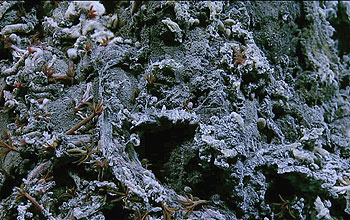All Images
News Release 05-166
Scientists to Use HDTV for a High-Definition Look at Surreal Sea Floor
Public can see broadcasts on cable, dish and Internet
This material is available primarily for archival purposes. Telephone numbers or other contact information may be out of date; please see current contact information at media contacts.

Ocean scienitsts prepare the high-definition TV camera for loading onto a remotely operated vehicle that will be dropped off the ship's side and down into a surreal environment on the sea floor.
Credit: Image provided courtesy of the VISIONS05 expedition (www.VISIONS05.washington.edu)
Download the high-resolution JPG version of the image. (150 KB)
Use your mouse to right-click (Mac users may need to Ctrl-click) the link above and choose the option that will save the file or target to your computer.

This picture of a tube-worm colony was taken with a high-definition video camera, which gives seven to 10 times the clarity of standard definition.
Credit: Image provided courtesy of the VISIONS05 expedition (www.VISIONS05.washington.edu)
Download the high-resolution JPG version of the image. (2.2 MB)
Use your mouse to right-click (Mac users may need to Ctrl-click) the link above and choose the option that will save the file or target to your computer.

The research vessel Thomas G. Thompson is 274 feet long and has 22 crew members and officers. In addition, 36 scientists and two marine technicians can be taken aboard for a research expedition. The Thompson, which, is owned by the Office of Naval Research and operated by the School of Oceanography, University of Washington, hosts a variety of remotely operated vehicles such as Jason II and the Canadian ROPOS.
Credit: Image provided courtesy of the VISIONS05 expedition (www.VISIONS05.ocean.washington.edu)
Download the high-resolution JPG version of the image. (50 KB)
Use your mouse to right-click (Mac users may need to Ctrl-click) the link above and choose the option that will save the file or target to your computer.

Jason II, a robotic vehicle tethered to the vessel Thompson by a fiber optic cable, will carry the HDTV camera to the ocean floor. It is designed to conduct a diverse range of scientific investigations in the world's oceans. The remotely operated vehicle system also includes the vehicle Medea, which serves to help with tether management such that when Jason, is at depth it is not highly impacted by wave action at the surface of the ocean. The fiber optic tether runs from the ship to Medea, and to Jason, to provide real-time communication to and from the vehicles, and to deliver streaming of video and digital still imagery from several cameras into the command center on the ship.
Credit: Image provided courtesy of the VISIONS05 expedition (www.VISIONS05.ocean.washington.edu)
Download the high-resolution JPG version of the image. (901 KB)
Use your mouse to right-click (Mac users may need to Ctrl-click) the link above and choose the option that will save the file or target to your computer.

VISIONS '05 involves several complex programs with science parties and science teachers from multiple institutions in the United States and Canada. The expedition focuses on one of the most geologically and biologically active sites in the global network of mid-ocean ridges: the suite of undersea hot springs associated with the volcanoes located in the Endeavour hydrothermal field at the northern end of the Juan de Fuca Ridge.
Credit: Image provided courtesy of the VISIONS05 expedition (www.VISIONS05.washington.edu)
Download the high-resolution JPG version of the image. (193 KB)
Use your mouse to right-click (Mac users may need to Ctrl-click) the link above and choose the option that will save the file or target to your computer.


